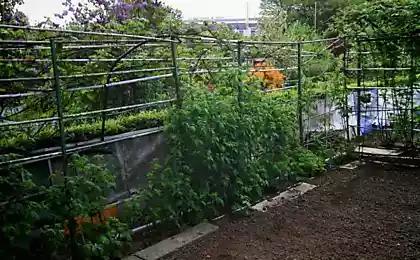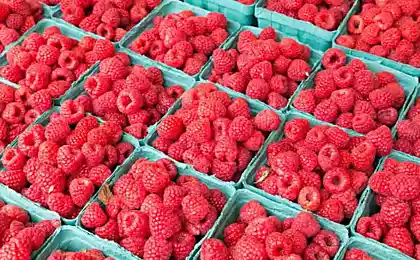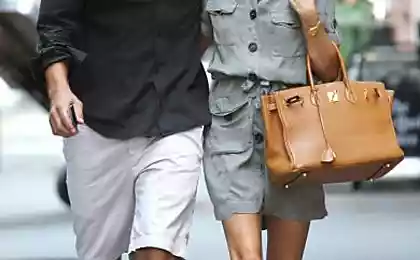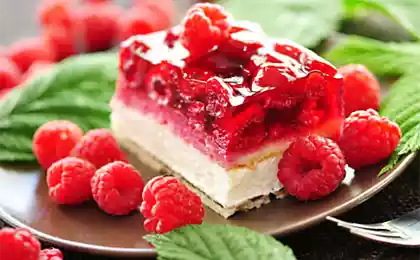898
My favorite berry in our garden: propagated raspberry CORRECT
Raspberry, so beloved by all growers in the amount and methods of reproduction time can surprise even novice gardeners grow it.
More versatile plants and you will not find. But if you do not look for it, it may flood the entire area.
And now - about the very reproduction
.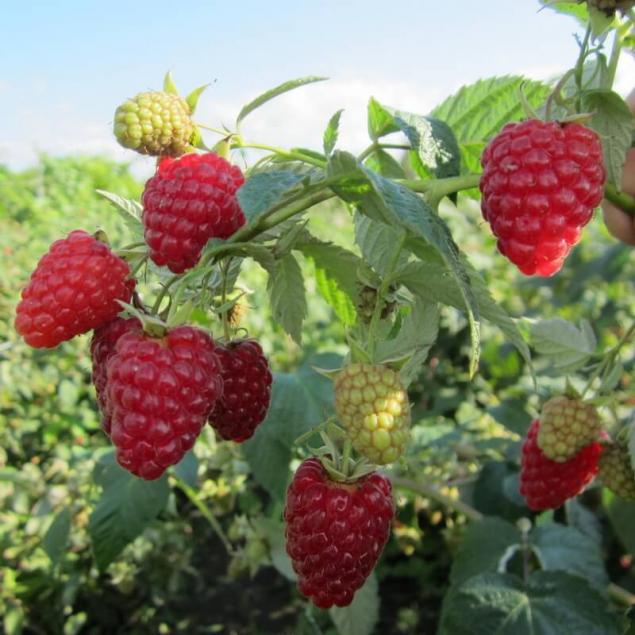
Seed.
This is the most difficult and time-consuming method, in my opinion, for the usual summer resident gardener-he and the least interesting. Anyway, I they had never enjoyed. In general, he's just there and we know about it now.
Green cuttings.
The method for those who have the time and desire to do planting in the summer and you have on the site already growing raspberries. To this end, under the 2-3 year old bushes we find young shoots (usually 2-5 centimeters in height with 2-3 leaves), carefully cut away with a knife or shears at ground level or deepening pruner 2-3 centimeters into the ground.
Do it better in the evening or, in non-solar weather. If desired, can be treated with stem growth factor to accelerate root growth can be soaked overnight.
A utrechkom planted in the nursery prepared (or mesh tank) - If the cuttings are many, or in individual cups in the wet ground. Well, if there is a small greenhouse or shelter can be made from the film.
Caring about both seedlings (watered regularly, can not fertilize a lot). A month later, the seedlings should appear at the roots and will need to be watered less frequently. And in the fall, along with a clod of earth planted in our planned place in the open ground.
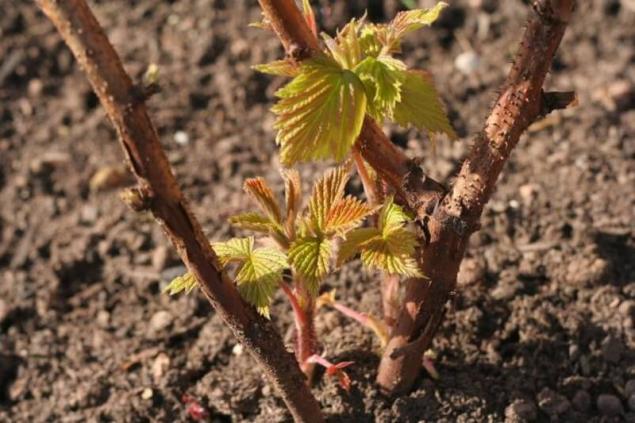
Root cuttings.
It's not very common for ordinary gardeners raspberry breeding method. Basically it is used in the nursery where you need a large number of for sale.
They (or root cuttings in a simple roots) are planted in the greenhouse until the young shoots, which are cut on the green cuttings for further planting.
The roots are also used to weed out when the raspberry bushes. If there were some rare species, or simply decided to no good to disappear. At the same time take roots thicker than 2 millimeters and a length of about 10 centimeters, and immediately planted. They put in a trench about 5 centimeters deep dug on prepared beds (fertilized and digging). After that, watered and mulch. In the spring (early) mulch rake and cover future seedlings film for 2 weeks.
The main plus of root cuttings - is ease of transportation and shipment. In this way they use for breeding remontant raspberries and a limited number of elite varieties. From 1 kg of roots, you can receive up to 500 seedlings.
Suckers.
This is the easiest and the most wonderful way. Because all but the transplant, the nature has made for us. And she herself, without our help, many things makes it much better than with our participation.
Root offshoots are those that grow by the end of next summer with older stems of raspberries. In principle, not necessarily close, they can crawl from the main bush per meter or more. I experienced gardeners are familiar with it.
Root offshoots can be planted (or rather is deposited on the main bush) when they grow 15-20 cm and more. And if you wait until the fall, they dig (take with a clod of earth) and land on the prepared, dug and fertilized place the seedling will be accepted better. After planting, they should be a little pritenit and give plenty of water.
Often at the end of the summer, especially on the black and purple raspberries, shoot apex sloping towards the ground. The top is like a loop, and at this point it is ready to take root. This loop can be prikopat, but in nature it often happens by itself. By the end of the fall, he will take root and the offspring of such can be transplanted (both autumn and spring).
This method is a bit like the dripping of lateral shoots at reproduction of gooseberries, currants and cranberries. Some gardeners cut off the tip and shank made of it (on the handle left of the sheet 2, and the rest is removed together with the growing point).
It remains to stalk about 12-15 centimeters with a cropped top, that is, two and a half internodes. On the bottom half of interstitials, for better appearance of the roots, causes the longitudinal scratches. Then put the cutting in clean water (if there is rain, then just great) to the depth of our cuts. By the way this trick can be carried out with roses.
More versatile plants and you will not find. But if you do not look for it, it may flood the entire area.
And now - about the very reproduction
.

Seed.
This is the most difficult and time-consuming method, in my opinion, for the usual summer resident gardener-he and the least interesting. Anyway, I they had never enjoyed. In general, he's just there and we know about it now.
Green cuttings.
The method for those who have the time and desire to do planting in the summer and you have on the site already growing raspberries. To this end, under the 2-3 year old bushes we find young shoots (usually 2-5 centimeters in height with 2-3 leaves), carefully cut away with a knife or shears at ground level or deepening pruner 2-3 centimeters into the ground.
Do it better in the evening or, in non-solar weather. If desired, can be treated with stem growth factor to accelerate root growth can be soaked overnight.
A utrechkom planted in the nursery prepared (or mesh tank) - If the cuttings are many, or in individual cups in the wet ground. Well, if there is a small greenhouse or shelter can be made from the film.
Caring about both seedlings (watered regularly, can not fertilize a lot). A month later, the seedlings should appear at the roots and will need to be watered less frequently. And in the fall, along with a clod of earth planted in our planned place in the open ground.

Root cuttings.
It's not very common for ordinary gardeners raspberry breeding method. Basically it is used in the nursery where you need a large number of for sale.
They (or root cuttings in a simple roots) are planted in the greenhouse until the young shoots, which are cut on the green cuttings for further planting.
The roots are also used to weed out when the raspberry bushes. If there were some rare species, or simply decided to no good to disappear. At the same time take roots thicker than 2 millimeters and a length of about 10 centimeters, and immediately planted. They put in a trench about 5 centimeters deep dug on prepared beds (fertilized and digging). After that, watered and mulch. In the spring (early) mulch rake and cover future seedlings film for 2 weeks.
The main plus of root cuttings - is ease of transportation and shipment. In this way they use for breeding remontant raspberries and a limited number of elite varieties. From 1 kg of roots, you can receive up to 500 seedlings.
Suckers.
This is the easiest and the most wonderful way. Because all but the transplant, the nature has made for us. And she herself, without our help, many things makes it much better than with our participation.
Root offshoots are those that grow by the end of next summer with older stems of raspberries. In principle, not necessarily close, they can crawl from the main bush per meter or more. I experienced gardeners are familiar with it.
Root offshoots can be planted (or rather is deposited on the main bush) when they grow 15-20 cm and more. And if you wait until the fall, they dig (take with a clod of earth) and land on the prepared, dug and fertilized place the seedling will be accepted better. After planting, they should be a little pritenit and give plenty of water.
Often at the end of the summer, especially on the black and purple raspberries, shoot apex sloping towards the ground. The top is like a loop, and at this point it is ready to take root. This loop can be prikopat, but in nature it often happens by itself. By the end of the fall, he will take root and the offspring of such can be transplanted (both autumn and spring).
This method is a bit like the dripping of lateral shoots at reproduction of gooseberries, currants and cranberries. Some gardeners cut off the tip and shank made of it (on the handle left of the sheet 2, and the rest is removed together with the growing point).
It remains to stalk about 12-15 centimeters with a cropped top, that is, two and a half internodes. On the bottom half of interstitials, for better appearance of the roots, causes the longitudinal scratches. Then put the cutting in clean water (if there is rain, then just great) to the depth of our cuts. By the way this trick can be carried out with roses.
Ayurvedic Marma massage of the face - an effective means of rejuvenation
Autonomous mobile mini house Room to Move






